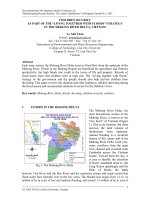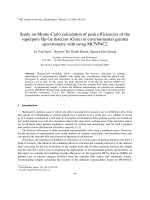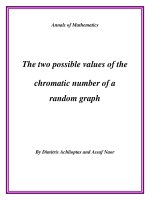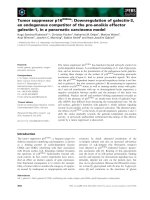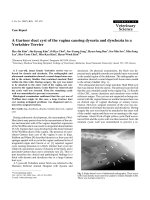Select hematological values of the african catfsh (clarias gariepinus) raised in a water recirculating aquaculture system
Bạn đang xem bản rút gọn của tài liệu. Xem và tải ngay bản đầy đủ của tài liệu tại đây (238.48 KB, 12 trang )
Hematological Values of Catfish in RAS.
Select Hematological Values of the African Catfish
(Clarias gariepinus) Raised in a Water Recirculating
Aquaculture System
O.A. Akinrotimi,1 D.O Bekibele,1 O.O. Orokotan2
1
African Regional Aquaculture Centre
Nigeria Institute for Oceanography and Marine Research
P.M.B. 5122, Port Harcourt, Rivers State, Nigeria
2
Gabrovic Agric Nigeria Limited, Fishery Consultancy
Services
100 East-West Road, Eliozu Junction, Port Harcourt,
Rivers State, Nigeria
Keywords: Hematology, recirculation, catfish aquaculture, Nigeria
ABSTRACT
Clinical evaluation of blood parameters is routinely used to assess the
health of wild and domestic animals. The commercial catfish industry in
Nigeria has undergone rapid expansion in recent years. An understanding
of normal hematology values for healthy fish and the identification
of predictors of the onset of health problems may enable fish health
specialists to intervene before major losses occur. This paper reports
values for selected hematological parameters of normal healthy African
catfish (Clarias gariepinus) (n=120) raised in a recirculating aquaculture
water recirculation system, including hemoglobin (Hb), red blood cells
(RBC), packed cell volume (PCV), white blood cells (WBC), mean
corpuscular volume (MCV), mean corpuscular hemoglobin (MCH), mean
corpuscular hemoglobin concentration (MCHC), thrombocyte count,
and leukocyte differential (lymphocytes, neutrophils and monocytes).
Significant differences (p< 0.05) were observed between males and
females in the values of Hb, PCV, and thrombocytes. This work provides
hematological baselines for selected values for Clarias gariepinus in
recirculation systems, and is intended to enhance production performance
through early detection and identification of infectious diseases.
International Journal of Recirculating Aquaculture 12 (2011) 1-12. All Rights Reserved
© Copyright 2011 by Virginia Tech, Blacksburg, VA USA
International Journal of Recirculating Aquaculture, Volume 12, June 2011
1
Hematological Values of Catfish in RAS.
INTRODUCTION
The African catfish, (Clarias gariepinus), belongs to the family Claridae,
and is the most popular fish cultured in Nigeria, next to the tilapine
fishes (FAO 1997, Adeogun et al. 2007). Aquaculture production in
Nigeria was concentrated on tilapia culture before the clariids began to
assert special importance in fish production in many parts of the country
(AIFP 2004). According to De-Graaf and Janssen (1996), the reasons
for preference of the clariids in tropical aquaculture includes hardiness
to adverse environmental conditions, fast growth rates in captivity,
easy procurement of fingerlings, adaptation to artificial feed, and high
consumer preference. Additional attributes of this species, relevant
to culture include high fecundity, potential for year-round induction
of final oocyte maturation, remarkable nutrient conversion efficiency,
and tolerance of high culture density (Legendre et al. 1992, Ayinla and
Nwadukwe 2003).
With the recent expansion of the catfish industry in Nigeria, many
farmers are now raising their fish using recirculating aquaculture
systems. This is a clear departure from the traditional earthen pond
culture system, which makes fish production seasonal and unreliable, to
a more advanced, reliable, intensive, and results-oriented culture system
(Akinrotimi et al. 2007a, Gabriel et al. 2009). With this level of intensive
stocking density of fish, there is therefore the need to monitor the health
status of cultured fish to prevent the outbreak of devastating diseases.
One of the difficulties in assessing the health of fish has been the scarcity
of reliable references describing the normal condition. To achieve this
goal, fish physiologists have employed hematology assessments to
characterize the physiological status of fish (Kori-Siakpere et al. 2005).
According to Wedemeyer et al. (1983), hematological studies are carried
out in fish to ascertain the normal values in relation to age, sex, and
culture system. Therefore the establishment of reference values with
accepted limits is important for comparison of data obtained from a
wild population with that of fish maintained in aquaculture conditions.
With this information, significant changes in these values can be used to
interpret the metabolic condition and overall health of fish (Gabriel et al.
2007a, Akinrotimi et al. 2007b).
Previous studies have determined blood parameters for this species in
various culture systems such as reservoirs (Sowunmi 2003; Ezeri et al.
2
International Journal of Recirculating Aquaculture, Volume 12, June 2011
Hematological Values of Catfish in RAS.
2004) and earthen ponds (Erondu et al. 1993, Omitoyin 2006, Akinrotimi
2008), but reports from recirculating aquaculture systems are lacking,
thus necessitating the need for this work. The objective of this study
was to report the hematological reference values for selected parameters
of Clarias gariepinus reared in a recirculating system using sufficient
numbers of fish to provide representative baseline values.
MATERIALS AND METHODS
Post-fingerlings of Clarias gariepinus were stocked in production
recirculating aquaculture systems at Watershed Fish Farms, Nigeria
Limited, Rumuodara, Port Harcourt, Rivers State, Nigeria and reared
to market size (average 1,800.00g ± 1.01SD) over 5 months. The
recirculating system in this farm measured 25m x 10m x 7m. The rate of
water flow was 40,000 liters/day and the water exchange was continuous,
with a stocking density of150 fish/m2. For this study, 200 apparently
healthy fish were carefully moved to other holding tanks to avoid stress
from crowding and maintained for ten days. The fish were later sexed
following the methods described by De-Graaf and Janssen (1996). The
following water quality parameters were determined daily for a period
of 10 days, and included temperature, pH, ammonia, nitrite, nitrate and
dissolved oxygen using methods described by APHA (1998).
The fish were individually restrained manually, then blood samples (5.0
mL) were collected from the caudal vessels of male and female fish
(60 each), using a heparinized plastic syringe fitted with a 21 gauge
hypodermic needle, and immediately transferred to EDTA tubes. After
collection of the blood samples, the fish were weighed (Sartorius model
H112, Portugal). Measurement of each blood parameter was repeated for
all 120 animals. Total RBC counts were obtained using a hemacytometer
(Improved Neubauer, Model BS-713, Weber Scientific Limited,
Middlesex, UK) using the method of Wintrobe (1934). Packed cell
volume (PCV) was determined by filling heparinized hematocrit capillary
tubes with blood, which was centrifuged for 5 minutes at 500×g in a
microhematocrit centrifuge (Model TDL60B, Hunan Xingke Scientific
Instruments Co. Ltd, Hunan, China), following the methods of Serveid
(1983). Hemoglobin was determined using the cyanmethemoglobin
method (Blaxlall and Daisley 1973). The total WBC counts (WBC) were
later enumerated in a hemacytometer (Improved Neubauer, Model BSInternational Journal of Recirculating Aquaculture, Volume 12, June 2011
3
Hematological Values of Catfish in RAS.
713, Weber Scientific Limited, Middlesex, UK) using Shaw’s diluting
fluid (Miale 1982). Blood smears were stained with Grumwald-Giemsa for
differential examination (Tavares Dias et al. 1999).
Statistical analysis was performed using SAS Software package (SAS
Institute Inc., Cary, NC, USA). One-way analysis of variance (ANOVA)
was applied to check for significant changes between male and female
fish. Statistically significant differences were determined by Tukey’s
multiple comparison test. The reference values were calculated based on
the minimum and maximum values of blood parameters (Zar 1996).
RESULTS AND DISCUSSION
The water quality parameters examined in this study indicated values
characteristic of recirculation systems (Hrubec and Smith 2004). All
parameters were within an acceptable range to enhance production
performance of cultured catfish (Table 1).
In fish medicine, hematological profiles are one of the most frequently
used methods to predict levels of disease and the impact of stressors in
fish. Hematological characteristics of a number of cultured fish species
have been studied, with the aim of establishing reference intervals
useful in cases where significant deviations may indicate a disturbance
in the physiological process (Raiza-Piava et al. 2000, Gabriel et al.
2004; Akinrotimi et al. 2007c). Many of these studies were attempted to
determine if significant variations from normal values could be attributed
to internal factors, or to factors external to the culture environment
(Gabriel et al. 2007b).
Several factors have been reported to affect hematological parameters
of teleost fish; these include species, sex, age, size, and environmental
and culture conditions (Sowunmi 2003; Akinrotimi et al. 2009). In
the assessment of the blood profile of black jaw tilapia, (Sarotherodon
melanotheron), Akinrotimi et al. (2007d) observed that results from the
female fish were consistently higher in all parameters examined, and
suggested the need to separate blood component data on the basis of sex.
In this present work, significant differences (p < 0.05) were found in
female fish for Hb, PCV, and total thrombocyte count (Table 2). Similar
findings were reported by Kori-Siakpere and Egor (1997) in Clarias
4
International Journal of Recirculating Aquaculture, Volume 12, June 2011
Hematological Values of Catfish in RAS.
buthapogun and Kori-Siakpere (1985) in C. isheriensis. The gender
differences may be due to the larger size of females (1900.00g ± 1.02SD)
and higher hormonal interaction compared with the males (1700.00g
± 1.02SD) (Sowunmi 2003). The higher values of Hb observed in the
female fish corroborate the reports of Akinrotimi et al. (2010) in Tilapia
guinnensis. The higher values of blood parameters associated with
oxygen transport suggest that under adverse environmental conditions
that impact negatively on available oxygen, the females may be better
equipped to handle such stressors than the males.
Values for hematological reference values determined in the 120
samples (Table 3) are comparable to those reported previously for
hybrid striped bass (Morone chrysops x Morone saxatilis) raised in
recirculating systems (Hrubec et al. 2004). The results were within the
same range except in the value of Hb content. The reference interval
of Hb in Clarias gariepinus (10.02-18.64 g/dL) was higher than that of
hybrid striped bass (4.2-8.4 g/dL). The difference may be due to speciesspecific variation of the fish (Nikinmaa 2001). Hemoglobin may also
show wide variability in sensitivity to effectors like organic phosphate,
environmental conditions, and various fish management procedures in
aquaculture (Angelids et al. 1987, Brauner and Randall 1999, Pelster
2001). However, the blood reference values obtained in this study
contradict those reported for yellow perch reared in recirculating systems
(Hrubec and Smith 2004). This difference may be due to species-specific
hematological characteristics in teleost fish. Mauel et al. (2007) reported
that species origin and breeding systems can influence hematological
reference values in fish, as observed in Tilapia species maintained in
recirculating systems. The hematological variables observed in this work
were lower than those obtained previously for C. gariepinus cultured
in freshwater tidal earthen ponds (Akinrotimi 2008). The higher values
of C. gariepinus in tidal earthen ponds may be due to relatively high
physical and metabolic activity in the fish raised in tidal systems, which
are known to elicit a higher erythrocyte to plasma ratio in response to
tidal shifts, which occur every six hours (Akinrotimi et al. 2010b).
Hence, the data reported in this study and those published previously
indicate that these values can be a useful tool for veterinarians and
aquaculturists in evaluating the health of cultured African catfish in
recirculating aquaculture systems.
International Journal of Recirculating Aquaculture, Volume 12, June 2011
5
Hematological Values of Catfish in RAS.
Table 1. Water quality parameters in the recirculating aquaculture system fo Af ican catfish Cla ias ga ie inus o e
a s.
6
Parameter
Mean ± SD
Range Min-Max
Temp (oC)
28.66 ± 4.21
26.44 – 30.64
pH
7.64 ± 1.21
6.81 – 8.12
Dissolved oxygen (mg/L)
6.91 ± 1.02
5.81 – 7.99
Ammonia (mg/L)
0.016 ± 0.02
0.004 – 0.027
Nitrite (mg/L)
0.014 ± 0.01
0.006 – 0.024
Nitrate (mg/L)
3.64 ± 0.61
2.01 – 5.67
International Journal of Recirculating Aquaculture, Volume 12, June 2011
a le . Hematological a amete s
in recirculating aquaculture system.
ean S
fo male an female Af ican catfish Cla ias ga ie inus
Female (n=60)
(W=1900.00g ±
1.02SD)
16.99 ± 3.26b
7.38 ± 1.22b
41.31 ± 1.21b
22.74 ± 3.66a
82.95 ± 9.74b
34.11 ± 5.22a
41.12 ± 6.34a
Male Reference
Parameter
Range
Hemoglobin (g 1D/dL)
10.02 – 16.74
12
Red blood cell (x10 /L)
3.05 – 6.99
Packed cell volume (%)
32.64 – 40.70
9
White blood cell (x10 /L)
18.66 – 23.98
Mean corpuscular volume (f1)
72.11 – 78.66
Mean corpuscular hemoglobin (pg)
30.21 – 36.22
Mean corpuscular hemoglobin
38.21 – 46.72
concentration (g/dL)
Thrombocytes (x109/L )
102.64 ± 1.11a
92.01 – 114.68
142.61 ± 7.11b
Lymphocytes (%)
64.22 ± 6.71a
51.14 – 70.10
64.64 ± 5.11a
Neutrophils (%)
32.14 ± 3.66a
28.21 – 40.14
31.58 ± 3.76a
Monocytes (%)
3.64 ± 1.14a
1.86 – 3.92
3.78 ± 1.31a
Where W = average weight
Means within the row are denoted with different superscripts where significant (P < 0.05)
Female
Reference Range
11.22 – 18.64
4.26 – 8.64
36.71 – 45.74
19.10 – 25.61
75.14 – 82.95
34.18 – 46.74
38.28 – 46.68
110.34 – 158.74
55.22 – 70.16
27.64 – 39.78
1.99 – 4.01
Hematological Values of Catfish in RAS.
International Journal of Recirculating Aquaculture, Volume 12, June 2011
Male (n=60)
(W=1700.00g
± 1.01SD)
14.86 ± 2.42a
4.98 ± 0.81a
36.21 ± 4.11a
21.68 ± 3.41a
72.71 ± 10.32a
33.92 ± 4.61a
41.63 ± 7.11a
ea e
7
Hematological Values of Catfish in RAS.
a le . Hematological efe ence alues of Af ican catfish Cla ias
gariepinus, reared in a recirculating aquaculture system (n = 120).
Parameter
Mean ± SD
Reference range
Hemoglobin (g/dL)
15.93 ± 4.61
10.02 - 18.64
Red blood cell (x10 /L)
4.68 ± 1.71
3.051 - 8.64
Packed cell volume (%)
38.76 ± 8.42
32.64 - 45.74
White blood cell (x109/L)
22.21 ± 6.46
18.66 - 25.61
Mean corpuscular volume (f1)
82.81 ± 9.66
72.11 - 91.34
Mean corpuscular
hemoglobin (pg)
34.02 ± 6.01
30.21 - 46.74
Mean corpuscular hemoglobin
concentration (g/dL)
41.38 ± 7.11
38.21 - 46.74
122.63 ± 12.61
92.01 - 158.74
Lymphocytes(%)
64.43 ± 9.64
51.14 - 70.16
Neutrophils (%)
31.86 ± 6.42
27.64 - 40.14
Monocytes (%)
3.71 ± 1.02
1.86 - 4.01
15.93 ± 4.61
10.02 – 18.64
Red blood cell (x10 /L)
4.68 ± 1.71
3.051 – 8.64
Packed cell volume (%)
38.76 ± 8.42
32.64 – 45.74
White blood cell (x10 /L)
22.21 ± 6.46
18.66 – 25.61
Mean corpuscular volume (f1)
82.81 ± 9.66
72.11 – 91.34
Mean corpuscular
hemoglobin (pg)
34.02 ± 6.01
30.21 – 46.74
Mean corpuscular hemoglobin
concentration (g/dL)
41.38 ± 7.11
38.21 – 46.74
122.63 ± 12.61
92.01 – 158.74
Lymphocytes (%)
64.43 ± 9.64
51.14 – 70.16
Neutrophils (%)
31.86 ± 6.42
27.64 – 40.14
Monocytes (%)
3.71 ± 1.02
1.86 – 4.01
12
Thrombocytes (x109/L)
Hemoglobin (g/dL)
12
9
Thrombocytes (x109/L)
Means within the row are denoted with different superscripts where
significant (P < 0.05)
8
International Journal of Recirculating Aquaculture, Volume 12, June 2011
Hematological Values of Catfish in RAS.
REFERENCES
Adeogun, O.A., Ogunbadejo, H.K., Ayinla, O.A., Oresegun, A.,
Oguntade O.R., Alhaji Tanko., William S.B. Urban aquaculture
production, perception and practices in Lagos State, Nigeria. Journal
Scientific Resea ch 2007. 2:21–27.
AIFP 2004. Africa International Food Programme Inventory of Feed
Produce in Nigeria. FAO Publ. FCT, Abuja, Nigeria.
Akinrotimi, O.A. 2008. Comparative hematology of some culturable
Clarrids raised in freshwater tidal and stagnant earthen ponds. MSc
Thesis. Rivers State University of Science and Technology, Port
Harcourt, Rivers State, Nigeria.
Akinrotimi, O.A., Abu, O.M.G., George, O.S., Uedeme – Naa, B.,
Aranyo, A.A. Hematological characteristics of Tilapia guineensis
from Buguma Creek, Niger Delta, Nigeria. Journal of League
Researchers in Nigeria 2010a, 11:177-182.
Akinrotimi, O.A., Uedeme-Naa, B., Agokei, E.O. Effects of acclimation
on hematological parameter of Tilapia guineensis (Bleeker, 1862).
Science World Journal 2010b, 5:1-4.
Akinrotimi, O.A., Abu, O.M.G., Ansa, E.J., Edun, O.M., George, O.S.
Hematological responses of Tilapia guineensis to acute stress.
International Journal of Natural and Applied Sciences 2009, 5:338348.
Akinrotimi, O.A., Ansa E.J., Owhonda, K.N. Onunkwo, D.N., Anyanwu,
P.E., Edun, O.M., Opara, J.Y., Cliffe, P.T. Effect of transportation
stress on haematological parameters of blackchin tilapia
Sarotherodon melanotheron. Journal of Animal and Veterinary
Advances 2007a, 6:841-845.
Akinrotimi, O.A., Ansa, E.J., Owhonda K.N., Edun, O.M., Onunkwo,
D.N., Opara, J.Y., Anyanwu, P.E. Amachree, D. Variations in oxygen
carrying capacity of Sarotherodon melanotheron blood in different
acclimation media. Journal of Animal and Veterinary Advances
2007b, 6:932-937.
Akinrotimi, O.A., Gabriel, U.U., Anyanwu, P.E., Anyanwu, A.O.
Influence of sex, acclimation methods and period on hematology of
International Journal of Recirculating Aquaculture, Volume 12, June 2011
9
Hematological Values of Catfish in RAS.
Sarotherodon melanotheron, Research Journal Biological Sciences
2007c, 2:248-352.
Akinrotimi, O.A., Gabriel, U.U., Owhonda, K.N., Onunkwo,
D.N., Anyanwu P.E., Opara, J.Y, Cliffe, P.T. Formulating an
environmentally friendly fish feed for sustainable aquaculture
development in Nigeria. Agricultural Journal 2007d, 2:606-612.
APHA 1998. American Public Health Association Standard Methods for
the Examination of Water and Waste Water, 17th ed. Washington DC.
1394pp.
Angelids, P.F., Bau diri –lau Rencih. Yoinu, P. Stress in rainbow trout,
Salmo gairdneri. Effects on phagocyte chemical luminescence
circulatory leucocytes and susceptibility to Aeromonas salmonicide.
Journal of Fish Biology 1987, 31:113-122.
Ayinla, O.A., Nwadukwe, F.O. Review of the development of hybrid
(Heteroclarias) of Clarias gariepinus and Heterobranchus bidorsalis.
Nigerian Journal of Fisheries 2003, 1:85-98.
Blaxhall, P.C., Daisley, K.W. Routine hematological methods for use in
fish blood. Journal of Fish Biology 1973, 5:771-781.
Brauner, C.J., Randall, D.J. 1998. The linkage between oxygen and
carbon dioxide transport. In: Penny, S.Y., B.L Tupts (Eds). Fish
Respiration. Academy press, San Diego. U.S.A
De Graaf, G., Janssen. H. Tropical production and pond rearing of the
Africa catfish Clarias gariepinus in sub-Saharan Africa. FAO Fish
Technical paper 1996, 326:1-20.
Erondu, E.S., Nnubia, C., Nwadukwe, F.O. Hematological studies in
four catfish species raised in fresh water ponds in Nigeria. Journal of
Applied Ichthyology 1993, 9:250-256.
Ezeri, G.N.O., Gabriel, U.U., Opabunmi, O.O. Hematological response
of cultured and wild Clarias gariepinus to acclimation. Environment
and Ecology 2004, 3:628-632.
FAO 1997. Food and Agriculture Organization Data Base on Introduced
Aquatic Species, FAO, Rome, Italy.
10
International Journal of Recirculating Aquaculture, Volume 12, June 2011
Hematological Values of Catfish in RAS.
Gabriel, U.U., Anyanwu, P.E, Akinrotimi, O.A. Blood characteristics
associated with confinement stress in black chin tilapia Sarotherodon
melanotheron. Journal Fish International 2007a, 2:186-189.
Gabriel, U.U., Anyanwu, P.E., Akinrotimi, O.A. Hematological profile
of black chinned tilapia (Sarotherodon melanotheron) from Buguma
creek, Niger Delta. Agricultural Journal 2007, 2:384-387.
Gabriel, U.U., Ezeri, G.N.O., Opabunmi. Influence of sex, source, health
status and acclimation on the hematology of Clarias gariepinus.
African Journal of Biotechnology 2004, 3:463-467.
Gabriel, U.U., Akinrotimi, O.A., Orokotan, O.O. Water recirculatory
system. A revolutionary tool for sustainable aquaculture development
in Nigeria. International Journal of Agriculture and Rural
Development 2009, 12:121-133.
Hrubec, T.C., Smith, S.A. Hematology and blood chemistry intervals
for yellow perch (Perca a escent) reared in a recirculation system.
International Journal of Recirculation Aquaculture 2004, 5:29-42.
Hrubec, T.C., Smith, S.A., Robertson, J.L. Age-related changes in
hematology and plasma chemistry values of hybrid striped bass,
Morone chrysops and Morore saxatilis. Veterinary Clinical
Pathology 2004, 30:8-5.
Kori-Siakpere, O., Ake, O.J. G., Idoge, E. Hematological characteristics
of the African snakehead, Parachanna obscura. African Journal
Biotechnology 2005, 4:527-530.
Kori-Siakpere, O., Egor, V.E. Hematological characteristics of the
African mud catfish Clarias buthopogon. Bulletin of Science
Association of Nigeria 1997, 21:177-185
Kori-Siakpere, P. Hematological characteristics of Clarias isheriensis.
Journal of Fish Biology 1985, 27:259-263.
Legendre, M., Tougels, G.G., Caunty, C., Jalaber, B. A comparative
study on morphology, growth rate and reproduction of Clarias
gariepimus (Burchell, 1822), Hete o anchus longifilis Valenciennes,
1840, and their reciprocal hybrids (Pisces, Clariidae). Journal of Fish
Biology 1992, 40:59-78.
International Journal of Recirculating Aquaculture, Volume 12, June 2011
11
Hematological Values of Catfish in RAS.
Mauel, M.Y., Miller, D.L., Merrill, A.H. Hematological and plasma
biochemical values of healthy hybrid tilapia (Oreochromis avreus x
Oreochromis mlotica) maintained in a recirculatory system. Journal
of Zoo and Wildlife Medicine 2007, 38:420-424.
Miale, J.B. 1982. Laboratory medicine hematology 6th ed. The C.V.
Mosby Co., London, UK.
Nikinmaa, M. Hemoglobin function and vertebrates voluntary changes
in cellular regulation in hemocyanin. Respiratory Physiology 2001,
128:317-329.
Omitoyin, B.O. Hematological and plasma parameters of cultured
Hete o anchus longifilis brood stock in Ibadan, Nigerian. Tropical
Journal of Animal Science 2006, 9:45-52.
Pelster, B. The generation of hyperbaric oxygen tensions in fish. News
Physiology Science 2001, 16:207-291.
Raiza-Paiva, M.J.T., Ishikawa, C.M., Das Eiras, A.A., Felizando, N.N.
2000. Hematological analysis of Pseudopladystoma fasciatus
in captivity. Aqua 2000: Responsible Aquaculture in the New
Millenium. Nice, France.
Seiverd, C.B. 1983. Hematology for Medical Technologists. Lea and
Febiger, Philadelphia, USA.
Sowummi, A.A. Hematology of the African catfish (Clarias gariepinus)
from Eleyele Reservoir, Ibadan South-West Nigeria. The Zoologist
2003, 2:85-91.
Tavares-Dias, M., Sandrim, E.F.S., Campus Filho, E. Caraterísticas
hematológicas do tambaqui Colossoma macropomum Cuvier
(Osteichthyes: Characidae) em sistema de monocultivo intensivo. II.
Leucócitos. Revista braxileira de Zoologia 1999, 16:175-184.
Wedemeyer, G.A., Gould, R.W., Yasutake, W.J. Some potentials and
limits of the leucocrit test as fish health assessment method. Journal
of Fish Biology 1983, 23:711-716.
Wintrobe, M.M. Variations in the size and hemoglobin content of
erythrocytes in the blood of various vertebrates. Folia Haematology
1934, 51:32-49.
Zar, J.H. 1996. Biostatistical Analysis, 3rd ed. Prentice Hall, New Jersey,
USA.
12
International Journal of Recirculating Aquaculture, Volume 12, June 2011

